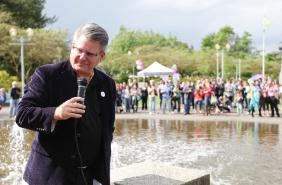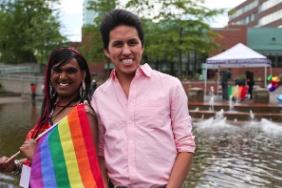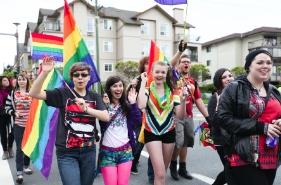
"All members of our community need to feel safe and secure . . . they need to feel they are given the opportunity to express themselves and to grow," Abbotsford Mayor Bruce Banman told the crowd. Credit: David P Ball photo

"We did not anticipate this big of a turnout!" said co-organizer Cherese Reemaul (with guest speaker Nathon Jimmy). Credit: David P Ball photo
More than 500 people took part in the Fraser Valley’s first Pride parade on May 25, according to police – a turnout that its Abbotsford organizers celebrated as larger than expected.
“We did not anticipate this big of a turnout!” co-organizer Cherese Reemaul told Xtra before taking the stage to address participants. “I’m a little bit overwhelmed.”
The inaugural Fraser Valley Pride march came five years after opponents deterred a student initiative to hold a parade in the heavily conservative, religious area. This year, not only did the city’s mayor speak at the parade, but Christian groups participated and called on co-religionists to reconsider their opposition to homosexuality.
The march filled several blocks of sidewalk along its route and passed several churches as well as a Bible college. The Lighthouse Church joined the parade carrying signs proclaiming, “We’re sorry for what the church has done to the GLBTQ community.”
As one congregation member explained, many people of faith are coming to terms with gay issues and becoming more accepting.
“I’ve been kicked out of many churches,” Otto von Bischoffshausen told Xtra. “I thought for a few years that God hated me with all his guts.
“But you have to look at the Bible as a whole. You can’t just isolate six different verses out of a huge Bible – it’s a huge book, and to take out six verses to destroy people? We can’t do that . . . God truly loves you for whoever you are.”
Abbotsford Mayor Bruce Banman told the crowd outside city hall that Pride is an opportunity to build awareness and support, particularly for youth.
“All members of our community need to feel safe and secure,” Banman said to applause. “They need to feel they can contribute to our community; they need to feel they are given the opportunity to express themselves and to grow.
“That is of fundamental importance to young people . . . who need to find their courage to find their place in the world and the opportunity to explore this in an environment with people that support them. I’d like to thank them for raising the profile of inclusivity and diversity in our community.”
For Reemaul, her first Pride march was a chance to not only honour diversity, but to celebrate Abbotsford’s growth.
In her speech, the transgender youth compared increasing acceptance of queer communities to how Europeans realized the Earth was round, not flat, centuries ago.
“Nobody would sail across the ocean because they would all fall off of it,” she reminded participants. “In the 21st century, in a little town called Abbotsford, nobody would come out and dress like this, wear boots or fancy hair because they thought, ‘They’re going to kill us’ or ‘They’re going to laugh at us.’
“Today, the Fraser Valley and beyond is going to be a different place.”
Abbotsford youth Joshua Baker told Xtra that the work of the Fraser Valley Youth Society – which tried to help organize the first unsuccessful Pride parade in 2008 and has since held annual Walk Away from Homophobia events – inspired him to come out to his mother.
“I’m gay myself and want to come in support of all my fellow friends,” he says. “I want everyone to know that being gay is okay.
“I’m hoping people take this as positive and really react well to it. I’ve been yelled at: ‘Gay!’ or ‘Queer!’ down the road, just by wearing this very pink shirt I’m wearing now.”
Also in attendance on Saturday was Peter Fassbender, newly elected member of the Legislative Assembly. The festivities concluded with a screening of Gwen Haworth’s documentary on her gender transition, She’s a Boy I Knew, followed by a panel discussion.

 Why you can trust Xtra
Why you can trust Xtra


